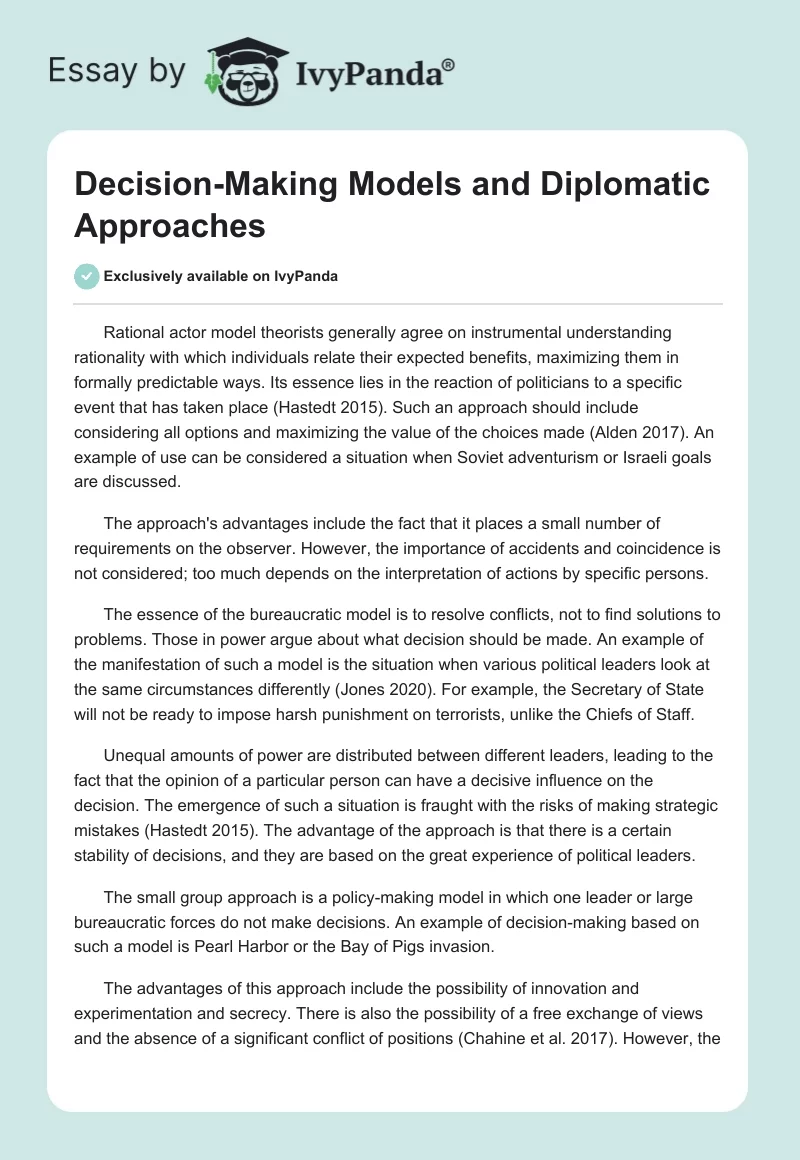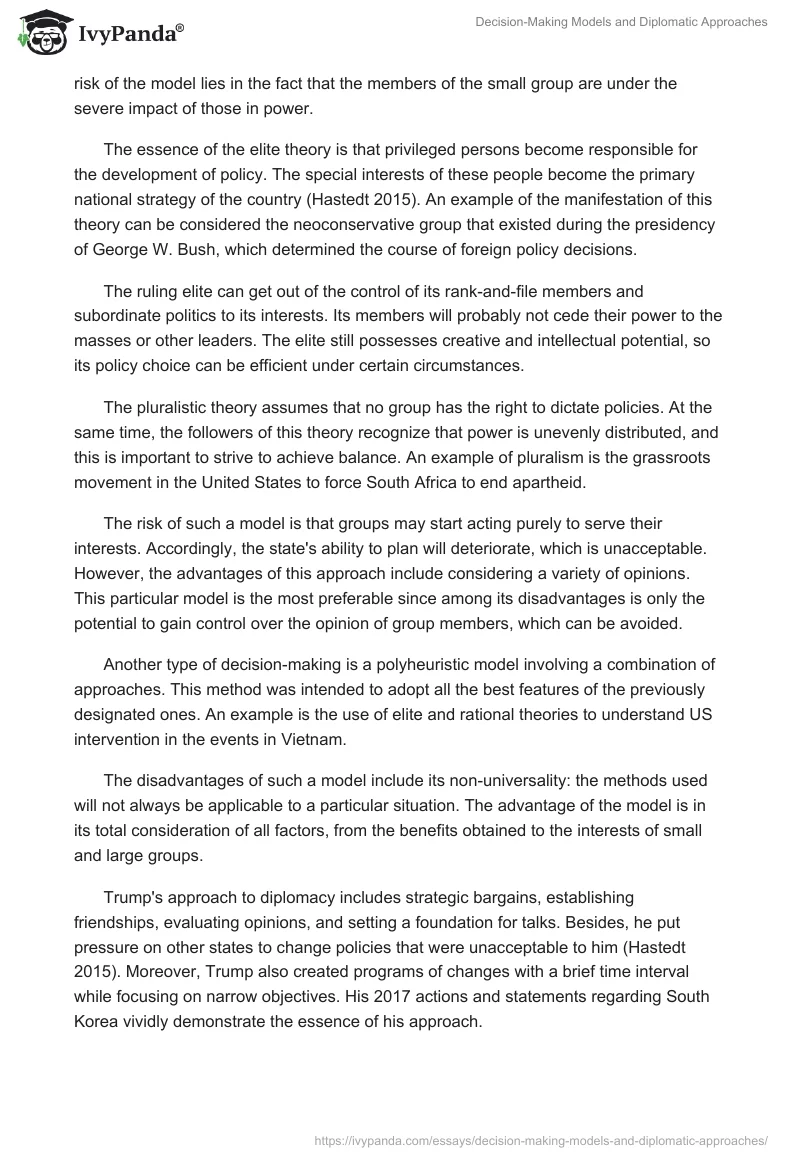Rational actor model theorists generally agree on instrumental understanding rationality with which individuals relate their expected benefits, maximizing them in formally predictable ways. Its essence lies in the reaction of politicians to a specific event that has taken place (Hastedt 2015). Such an approach should include considering all options and maximizing the value of the choices made (Alden 2017). An example of use can be considered a situation when Soviet adventurism or Israeli goals are discussed.
The approach’s advantages include the fact that it places a small number of requirements on the observer. However, the importance of accidents and coincidence is not considered; too much depends on the interpretation of actions by specific persons.
The essence of the bureaucratic model is to resolve conflicts, not to find solutions to problems. Those in power argue about what decision should be made. An example of the manifestation of such a model is the situation when various political leaders look at the same circumstances differently (Jones 2020). For example, the Secretary of State will not be ready to impose harsh punishment on terrorists, unlike the Chiefs of Staff.
Unequal amounts of power are distributed between different leaders, leading to the fact that the opinion of a particular person can have a decisive influence on the decision. The emergence of such a situation is fraught with the risks of making strategic mistakes (Hastedt 2015). The advantage of the approach is that there is a certain stability of decisions, and they are based on the great experience of political leaders.
The small group approach is a policy-making model in which one leader or large bureaucratic forces do not make decisions. An example of decision-making based on such a model is Pearl Harbor or the Bay of Pigs invasion.
The advantages of this approach include the possibility of innovation and experimentation and secrecy. There is also the possibility of a free exchange of views and the absence of a significant conflict of positions (Chahine et al. 2017). However, the risk of the model lies in the fact that the members of the small group are under the severe impact of those in power.
The essence of the elite theory is that privileged persons become responsible for the development of policy. The special interests of these people become the primary national strategy of the country (Hastedt 2015). An example of the manifestation of this theory can be considered the neoconservative group that existed during the presidency of George W. Bush, which determined the course of foreign policy decisions.
The ruling elite can get out of the control of its rank-and-file members and subordinate politics to its interests. Its members will probably not cede their power to the masses or other leaders. The elite still possesses creative and intellectual potential, so its policy choice can be efficient under certain circumstances.
The pluralistic theory assumes that no group has the right to dictate policies. At the same time, the followers of this theory recognize that power is unevenly distributed, and this is important to strive to achieve balance. An example of pluralism is the grassroots movement in the United States to force South Africa to end apartheid.
The risk of such a model is that groups may start acting purely to serve their interests. Accordingly, the state’s ability to plan will deteriorate, which is unacceptable. However, the advantages of this approach include considering a variety of opinions. This particular model is the most preferable since among its disadvantages is only the potential to gain control over the opinion of group members, which can be avoided.
Another type of decision-making is a polyheuristic model involving a combination of approaches. This method was intended to adopt all the best features of the previously designated ones. An example is the use of elite and rational theories to understand US intervention in the events in Vietnam.
The disadvantages of such a model include its non-universality: the methods used will not always be applicable to a particular situation. The advantage of the model is in its total consideration of all factors, from the benefits obtained to the interests of small and large groups.
Trump’s approach to diplomacy includes strategic bargains, establishing friendships, evaluating opinions, and setting a foundation for talks. Besides, he put pressure on other states to change policies that were unacceptable to him (Hastedt 2015). Moreover, Trump also created programs of changes with a brief time interval while focusing on narrow objectives. His 2017 actions and statements regarding South Korea vividly demonstrate the essence of his approach.
The disadvantages of this approach include an excessive emphasis on the personality of Trump himself. It turns out that his will becomes the key driver of the ongoing changes. The management strategies applied by the former president should be considered a merit. However, the success of his actions is a variable indicator, and therefore cannot be considered a sufficient advantage.
Shuttle diplomacy is a means of peaceful settlement of disputes between states through a series of negotiations with a third state (mediator) and based on conditions put forward by it. In some conflicts, direct communication between the parties can aggravate the situation. Henry Kissinger began what became known as “shuttle diplomacy” between Jerusalem and the Arab capitals (Hastedt 2015). His actions contributed to the cessation of hostilities in these countries after the Yom Kippur War.
The risk of this method is that the parties will still fail to reach a peace agreement. Moreover, it is also possible that the third party will pursue its own goals. However, this approach can indeed reduce the conflict, which can but be attributed to its merits.
Summit diplomacy is a meeting of heads of state at meetings. They enable communication between leaders and a deadline for the enactment of specific initiatives. Moreover, such meetings energize bureaucracy and facilitate the formulation of previously unspoken requests and demands. Trump’s Singapore meeting with Kum Jung-un is an example of this approach to diplomacy.
However, the intensification of bureaucracy does not always lead to the emergence of politics. Moreover, the limited period is also a controversial point in this approach since an ever-changing problem cannot always be resolved when political leaders need it. Nevertheless, the exact format of the meetings increases the countries’ willingness to cooperate. Many vital initiatives have been implemented through conferences, demonstrating their high impact.
Conference diplomacy occurs when a problem affects the interests of too many states. International conferences can be classified according to different criteria depending on the general and operational goals, objectives, scope of activity of its participants, etc. An example of this approach is the coalition of support in the Iranian war created by George W. Bush. Its essence was to take military action against the Gaddafi regime.
The risk of the approach is that agreement can possibly not be reached. As in the previous case, the deadlines may be deliberately shortened or lengthened. Communication problems may arise due to difficulties in translation or deliberate distortion of the speaker’s words. This method includes all the same benefits as meeting diplomacy. This approach seems to be the most successful among all those analyzed since it makes it possible to define and implement initiatives effectively.
The UN diplomatic approach aims to maintain peace, interpreted as the need for a UN presence in the area of the conflict. It assumes the implementation of measures aimed at establishing mutual trust between countries (Hastedt 2015). The UN is also linked with an early warning strategy that helps to save resources (Khankeh et al. 2019). An example is the UN’s efforts to impose sanctions on North Korea.
Although most UN programs and conventions are based on scientific research, the systematic use of scientific recommendations is not a key component of their productive activity. The UN arose during the Cold War when external aggression was at the forefront (Tromly 2020). Today, the world is more concerned with other issues, which this organization will not always be able to solve. The advantage of the analyzed approach is the UN’s credibility, power, and international character.
Public democracy is designed to influence public opinion. At the same time, its essence is not only in words but also in programs and practices to achieve its goals. An example is Obama’s foreign policy, which allowed him to win the Nobel Prize.
This type of diplomacy can be used for political manipulations of the leaders. In addition, speaking and publishing development programs do not confirm that changes will necessarily occur, which will only disappoint the public. However, the advantage of this method should be considered the unconditional support guaranteed from the country’s inhabitants inspired by the speech of the political leaders.
Reference List
Alden, Chris. 2017. Critiques of the rational actor model and foreign policy decision making. Oxford: Oxford University Press.
Chahine, Saad, Sayra Cristancho, Jessica Padgett, and Lorelei Lingard. 2017. “How Do Small Groups Make Decisions: A Theoretical Framework to Inform the Implementation and Study of Clinical Competency Committees. Perspect Med Educ 6, no. 3:192-198. doi:10.1007/s40037-017-0357-x
Hastedt, Glenn. 2015. American foreign policy: Past, present, and future. London: Rowman & Littlefield.
Jones, Christopher. 2020. Bureaucratic Politics and Organizational Process Models. Oxford: International Studies Association and Oxford University Press.
Khankeh, Hamid Reza, Seyed Hossein Hosseini, Mehrdad Farrokhi, Mohammad Ali Hosseini and Nasir Amanat. 2019. “Early warning system models and components in emergency and disaster: a systematic literature review protocol.” Syst Rev 8: 1-4. doi:10.1186/s13643-019-1211-5
Tromly, Benjamin. “Émigré Politics and the Cold War: The National Labor Alliance (NTS), United States Intelligence Agencies and Post-War Europe.” 2020. Contemp Eur Hist 29, no. 1: 44-49 doi:10.1017/S0960777318000590.


